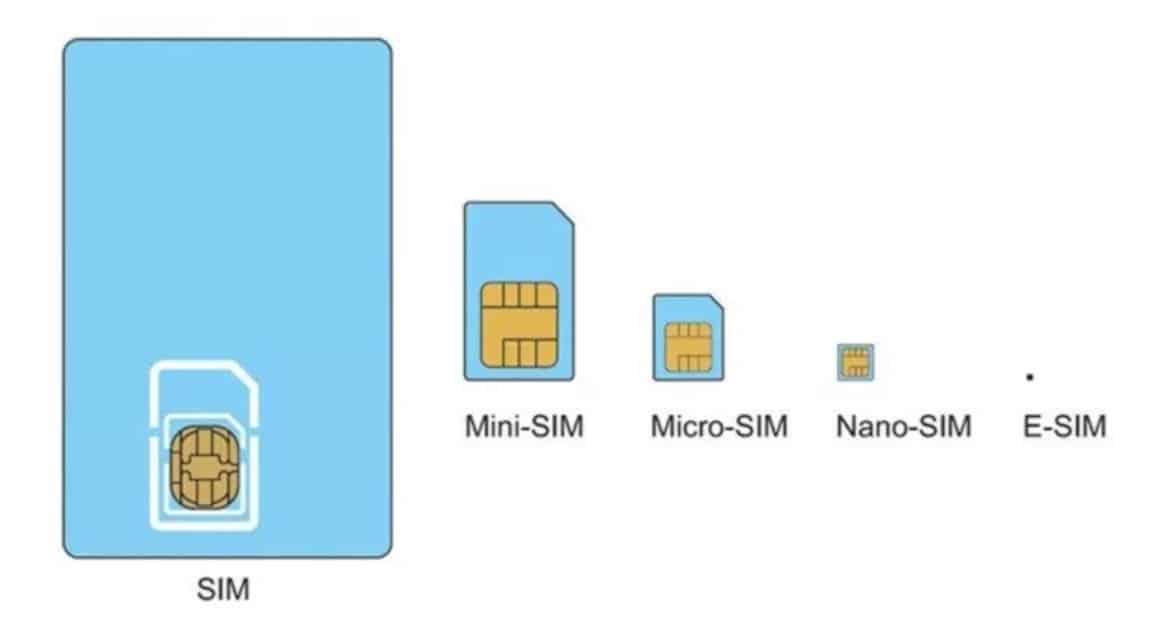eSIM devices from Apple, Samsung, and Huawei
The different types of SIM. src
Experts estimated eSIM shipments will increase by nearly nine times between 2016 and 2021 from 108.9 million to 986 million. Since its inception, eSIM technology has received an ever-growing wave of positive press, as it liberates customers of many limitations that come with traditional SIM cards.
eSIMs are embedded into devices so they can access mobile networks without using a traditional SIM card. The technology has mostly been deployed in industrial IoT systems, where it can be incorporated to make devices more portable and easier to maintain. In the consumer electronics market, the technology has mostly emerged in wearables and domestic IoT systems, where it lends itself to highly practical use.
Apple was the first major tech company to introduce eSIM to the consumer market, with iPhones XS, XS Max, XR, 11, and the Apple Watch Series 3 among the first-ever mass-produced eSIM-enabled devices. Other tech giants like Google (with the Pixel 3), Samsung, and Huawei soon joined.
Samsung’s eSIM line of devices mostly features smartwatches, with the Samsung Gear S2 and Gear S3 product lines becoming their first-ever eSIM product. To edge competition in the increasingly crowded space, the company released the eSIM-enabled Samsung Galaxy Watch, which is designed to support global roaming – something that other big players like Apple have backed away from.
Huawei’s Android-powered eSIM smartwatches also ranks among the best. It sports a 1.2-inch AMOLED display, a 76MR RAM, and a large 4GB internal memory.
Are there prepaid mobile plans and/or phone plans for eSIMs?
As a relatively new technology, there are only a few eSIM deals in Australia today. Only the major telcos offer eSIM support right now – Telstra, Optus, and Vodafone – MVNOs don’t yet have access to the technology.
Most eSIM deals are offered on a postpaid/contractual basis, with some providers reluctant to give customers access to the full potentials of eSIM, which would allow customers to switch easily between different service providers. Here’s a rundown of prepaid/postpaid eSIM plans from the top three telcos:
- Telstra:
Telstra’s eSIM products include the standard eSIM plans for compatible phones and tablets, One Number for wearables, and a separate offer for Windows 10 PCs. They come in prepaid and postpaid deals, except the One Number deals, which are only available through postpaid plans. Telstra also offers phone deals for top-draw eSIM devices like iPhone 11, iPhone XR, the latest models of iPad Pro, and Google Pixel 4 on a prepaid basis. - Optus:
Optus has two eSIM plans: Number Share for wearables and plans for eSIM enabled phones. However, the Number Share plans, like Telstra’s One Number, are not obtainable through prepaid deals. - Vodafone:
Vodafone also has two eSIM products – the standard eSIM plans for select eSIM-ready smartphones and NumberSync plans for wearables. All Vodafone’s eSIM plans are available in prepaid and postpaid arrangements.
How to activate eSIM
Most eSIM devices activate their eSIM networks automatically the first time you set them up or pair them with other devices. src
Each eSIM device comes with different setup requirements, but you’ll find all the setup instructions you need in the manual. Meanwhile, here’s an easy guide with simple steps for activating Apple and Samsung eSIM devices:
- Apple Smartwatches
Setting up eSIM network service on an Apple smartwatch is as simple as pairing the device with your iPhone, and then following the eSIM set-up prompts that popup next. You’ll be asked to sign into the eSIM network with your credentials and then choose between plans from One Number (Telstra), Number Share (Optus), or NumberSync (Vodafone). If you’ve already paired your Apple watch without setting up eSIM, you can do so later by going to the Watch App, and then navigating to the “Mobile” option, and selecting the “Set Up Mobile” option. You’ll then get an SMS from your carrier confirming the activation of your eSIM. - Samsung Galaxy Watch
If you’re pairing up your Galaxy Watch with your Samsung phone for the first time, you’ll see a pop-up window notifying you about activating eSIM. To set up eSIM on your Galaxy Watch, install and run the Galaxy Wearable app, and then go to “Start the Journey > Choose Galaxy Watch.” Next, you’ll see a prompt asking you to allow your phone to pair with your Galaxy Watch. After that, sign into your Samsung account, and that’s it. Your Galaxy Watch will automatically connect to a mobile network, and then you’ll be asked to choose an eSIM plan from Telstra, Optus, or Vodafone.
Summing up
eSIM is a relatively new technology in Australia, but you can still find highly attractive eSIM deals from various telcos. However, depending on your needs, you might need to stick to a specific telco, as each one of them has deals that lock you to the particular carrier.

